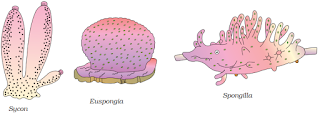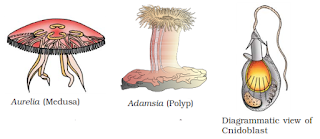Phylum Porifera
$\displaystyle \small \bullet$ Poriferans are pore bearing animals commonly called sponges.
$\displaystyle \small \bullet$ Most of the members are marine form, only few are fresh water forms.
$\displaystyle \small \bullet$ They are sedentary and are solitary or colonial. They are asymmetrical organisms with cellular level of organisation.
$\displaystyle \small \bullet$ They are diploblastic animals with an outer dermal layer, pinacoderm and inner gastral layer, choanoderm.
$\displaystyle \small \bullet$ The body of the animals is perforated by numerous pores called Ostia.
$\displaystyle \small \bullet$ They have water transport system. Water enters through ostia in the bodywall and into a central cavity, spongocoel and goes out through the osculum. This pathway of water transport is helpful in food gathering, respiratory exchange and removal of waste.
$\displaystyle \small \bullet$ Choanocytes or collar cells line the spongocoel and the canals.
$\displaystyle \small \bullet$ The internal skeleton is made up of various kinds of spicules and spongin fibres.
$\displaystyle \small \bullet$ Digestion is intracellular.
$\displaystyle \small \bullet$ All sponges are hermaphrodite. Asexual reproduction is by budding or gemmules. Sexual reproduction is by fusion of ova and spermatozoa.
$\displaystyle \small \bullet$ Development is indirect with larval stages called paranchymula.
$\displaystyle \small \bullet$ All the sponges have the power of regeneration.
$\displaystyle \small \bullet$ Ex: Sycon (Scypha), Spongilla (Fresh water Sponge), Euspongilla (Bath Sponge).

Phylum Coelenterata (Cnidaria)
$\displaystyle \small \bullet$ Members are commonly called coelenterates or Cnidarians.
$\displaystyle \small \bullet$ The name cnidaria (sting cells) is derived from cnidoblasts or cnidicytes present on the ectoderm of tentacles and body.
$\displaystyle \small \bullet$ All animals are aquatic, some are marine while some are fresh water.
$\displaystyle \small \bullet$ Animals are sedentary or free-swimming, solitary or colonial.
$\displaystyle \small \bullet$ They show tissue level of organisation with radial symmetry.
$\displaystyle \small \bullet$ Animals are diploblastic having outer ectoderm and inner endoderm. There is non-living mesoglea between two layers.
$\displaystyle \small \bullet$ There are two forms namely, free swimming medusa and sedentary polyp. Some of them shows alternation of generation (Metagenesis). Hydra have only polyp stage.
$\displaystyle \small \bullet$ Presence of nematocytes is a speciality of coelenterates. They help in capturing food and defense.
$\displaystyle \small \bullet$ Digestion is extracellular and intracellular, and have a central gastro-vascular cavity with a single opening, Hypostome.
$\displaystyle \small \bullet$ Nervous system consist of nerve net.
$\displaystyle \small \bullet$ Some cnidarians (e.g. corals) have skeleton composed of calcium carbonate.
$\displaystyle \small \bullet$ Asexual reproduction is by budding and fission. Sexual reproduction is by ovum and sperm.
$\displaystyle \small \bullet$ Development is indirect with free swimming planula larva.
$\displaystyle \small \bullet$ Many colonial cnidarians exhibit the phenomenon of polymorphism, where the individuals of the colony show morphological and functional differentiation.
$\displaystyle \small \bullet$ Ex: Physalia (Portuguese man of war), Adamsia (Sea anemone), Pennatula (Sea-pen), Gorgonia (Sea-fan), Meandrina (Brain coral).

Phylum Ctenophora
$\displaystyle \small \bullet$ The members are commonly known as sea walnuts or comb jellies.
$\displaystyle \small \bullet$ They are exclusively marine forms. They are found solitary, pelagic or free swimming.
$\displaystyle \small \bullet$ They are diploblastic animals with radial symmetry.
$\displaystyle \small \bullet$ They have tissue level of organisation.
$\displaystyle \small \bullet$ The body of animal bears eight ciliated comb plates which help in locomotion.
$\displaystyle \small \bullet$ Bioluminescence (property of a living organism to emit light) is found in ctenophores.
$\displaystyle \small \bullet$ Digestion is both extracellular and intracellular.
$\displaystyle \small \bullet$ Skeletal, circulatory, respiratory and excretory systems are absent.
$\displaystyle \small \bullet$ They are hermaphrodite. Reproduction is only by sexual method.
$\displaystyle \small \bullet$ Fertilisation is external and development is indirect.
$\displaystyle \small \bullet$ Ex: Pleurobrachia, Ctenoplana

Phylum Platyhelminthes
$\displaystyle \small \bullet$ They have dorso-ventrally flattened body hence, they are commonly called flat worms.
$\displaystyle \small \bullet$ Majority of animals are endoprasites. Few are free living forms.
$\displaystyle \small \bullet$ They are triploblastic, acoelomate animals with bilateral symmetry.
$\displaystyle \small \bullet$ They have organ level of organisation.
$\displaystyle \small \bullet$ Hooks and suckers are present in parasitic forms and some of them absorb nutrients from the host directly through their body surface.
$\displaystyle \small \bullet$ Body is externally covered by cuticle, it protects endoparasites from hormones and enzymes of host.
$\displaystyle \small \bullet$ Digestive system is usually absent, if present digestive tract is incomplete.
$\displaystyle \small \bullet$ They have specialized cells called flame cells which help in osmoregulation and excretion.
$\displaystyle \small \bullet$ These are hermaphrodites. Fertilization is internal and development is through many larval stages.
$\displaystyle \small \bullet$ Some members like Planaria have high regeneration capacity.
$\displaystyle \small \bullet$ Example: Taenia (Tapeworm), Fasciola (Liver fluke), Planaria.
$\displaystyle \small \bullet$ Poriferans are pore bearing animals commonly called sponges.
$\displaystyle \small \bullet$ Most of the members are marine form, only few are fresh water forms.
$\displaystyle \small \bullet$ They are sedentary and are solitary or colonial. They are asymmetrical organisms with cellular level of organisation.
$\displaystyle \small \bullet$ They are diploblastic animals with an outer dermal layer, pinacoderm and inner gastral layer, choanoderm.
$\displaystyle \small \bullet$ The body of the animals is perforated by numerous pores called Ostia.
$\displaystyle \small \bullet$ They have water transport system. Water enters through ostia in the bodywall and into a central cavity, spongocoel and goes out through the osculum. This pathway of water transport is helpful in food gathering, respiratory exchange and removal of waste.
$\displaystyle \small \bullet$ Choanocytes or collar cells line the spongocoel and the canals.
$\displaystyle \small \bullet$ The internal skeleton is made up of various kinds of spicules and spongin fibres.
$\displaystyle \small \bullet$ Digestion is intracellular.
$\displaystyle \small \bullet$ All sponges are hermaphrodite. Asexual reproduction is by budding or gemmules. Sexual reproduction is by fusion of ova and spermatozoa.
$\displaystyle \small \bullet$ Development is indirect with larval stages called paranchymula.
$\displaystyle \small \bullet$ All the sponges have the power of regeneration.
$\displaystyle \small \bullet$ Ex: Sycon (Scypha), Spongilla (Fresh water Sponge), Euspongilla (Bath Sponge).

Phylum Coelenterata (Cnidaria)
$\displaystyle \small \bullet$ Members are commonly called coelenterates or Cnidarians.
$\displaystyle \small \bullet$ The name cnidaria (sting cells) is derived from cnidoblasts or cnidicytes present on the ectoderm of tentacles and body.
$\displaystyle \small \bullet$ All animals are aquatic, some are marine while some are fresh water.
$\displaystyle \small \bullet$ Animals are sedentary or free-swimming, solitary or colonial.
$\displaystyle \small \bullet$ They show tissue level of organisation with radial symmetry.
$\displaystyle \small \bullet$ Animals are diploblastic having outer ectoderm and inner endoderm. There is non-living mesoglea between two layers.
$\displaystyle \small \bullet$ There are two forms namely, free swimming medusa and sedentary polyp. Some of them shows alternation of generation (Metagenesis). Hydra have only polyp stage.
$\displaystyle \small \bullet$ Presence of nematocytes is a speciality of coelenterates. They help in capturing food and defense.
$\displaystyle \small \bullet$ Digestion is extracellular and intracellular, and have a central gastro-vascular cavity with a single opening, Hypostome.
$\displaystyle \small \bullet$ Nervous system consist of nerve net.
$\displaystyle \small \bullet$ Some cnidarians (e.g. corals) have skeleton composed of calcium carbonate.
$\displaystyle \small \bullet$ Asexual reproduction is by budding and fission. Sexual reproduction is by ovum and sperm.
$\displaystyle \small \bullet$ Development is indirect with free swimming planula larva.
$\displaystyle \small \bullet$ Many colonial cnidarians exhibit the phenomenon of polymorphism, where the individuals of the colony show morphological and functional differentiation.
$\displaystyle \small \bullet$ Ex: Physalia (Portuguese man of war), Adamsia (Sea anemone), Pennatula (Sea-pen), Gorgonia (Sea-fan), Meandrina (Brain coral).

Phylum Ctenophora
$\displaystyle \small \bullet$ The members are commonly known as sea walnuts or comb jellies.
$\displaystyle \small \bullet$ They are exclusively marine forms. They are found solitary, pelagic or free swimming.
$\displaystyle \small \bullet$ They are diploblastic animals with radial symmetry.
$\displaystyle \small \bullet$ They have tissue level of organisation.
$\displaystyle \small \bullet$ The body of animal bears eight ciliated comb plates which help in locomotion.
$\displaystyle \small \bullet$ Bioluminescence (property of a living organism to emit light) is found in ctenophores.
$\displaystyle \small \bullet$ Digestion is both extracellular and intracellular.
$\displaystyle \small \bullet$ Skeletal, circulatory, respiratory and excretory systems are absent.
$\displaystyle \small \bullet$ They are hermaphrodite. Reproduction is only by sexual method.
$\displaystyle \small \bullet$ Fertilisation is external and development is indirect.
$\displaystyle \small \bullet$ Ex: Pleurobrachia, Ctenoplana

Phylum Platyhelminthes
$\displaystyle \small \bullet$ They have dorso-ventrally flattened body hence, they are commonly called flat worms.
$\displaystyle \small \bullet$ Majority of animals are endoprasites. Few are free living forms.
$\displaystyle \small \bullet$ They are triploblastic, acoelomate animals with bilateral symmetry.
$\displaystyle \small \bullet$ They have organ level of organisation.
$\displaystyle \small \bullet$ Hooks and suckers are present in parasitic forms and some of them absorb nutrients from the host directly through their body surface.
$\displaystyle \small \bullet$ Body is externally covered by cuticle, it protects endoparasites from hormones and enzymes of host.
$\displaystyle \small \bullet$ Digestive system is usually absent, if present digestive tract is incomplete.
$\displaystyle \small \bullet$ They have specialized cells called flame cells which help in osmoregulation and excretion.
$\displaystyle \small \bullet$ These are hermaphrodites. Fertilization is internal and development is through many larval stages.
$\displaystyle \small \bullet$ Some members like Planaria have high regeneration capacity.
$\displaystyle \small \bullet$ Example: Taenia (Tapeworm), Fasciola (Liver fluke), Planaria.




0 Comments